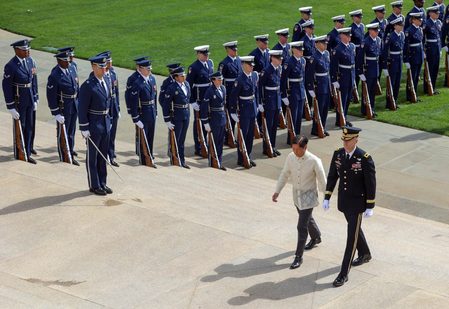SUMMARY
This is AI generated summarization, which may have errors. For context, always refer to the full article.

Claim: A video claims that the “Mutual Defense Guidelines of 2023” between the Philippines and the US poses an enhanced threat to China because it can now be invoked in case of an attack in the South China Sea.
It also claims that Philippine military forces had weakened and were neglected since the administration of former president Corazon Aquino, and that all the presidents before Ferdinand Marcos Jr. were “really afraid of Chinese might.”
Rating: FALSE
Why we fact-checked this: The video was posted on May 14 on a page with 73,000 followers. It has 5,800 reactions, 167,000 views, and 694 shares as of writing.

Updated defense guidelines: The video mistakenly refers to the Bilateral Defense Guidelines between the Philippines and the US as the “Mutual Defense Guidelines of 2023.” It conflates the recently-established defense guidelines with the 1951 Mutual Defense Treaty (MDT).
On May 3, the Philippines and the US agreed on new guidelines that reaffirm commitments under the 1951 MDT. The guidelines specifically mention that bilateral treaty commitments would be invoked if either country is attacked in the South China Sea.
The fact sheet for the Bilateral Defense Guidelines states: “The guidelines reaffirm that an armed attack in the Pacific, including anywhere in the South China Sea, on either of their public vessels, aircraft, or armed forces – which includes their Coast Guards – would invoke mutual defense commitments under Articles IV and V of the 1951 U.S.-Philippines Mutual Defense Treaty.”
MDT applies to South China Sea: The Facebook video highlights the new guidelines’ mention of the South China Sea, implying that the guidelines now pose more of a threat to China because it specifically mentions the disputed waters.
Article V of the 1951 MDT states that “an armed attack on either of the Parties is deemed to include an armed attack on the metropolitan territory of either of the Parties, or on the Island territories under its jurisdiction in the Pacific Ocean, its armed forces, public vessels or aircraft in the Pacific.”
However, even before the Bilateral Defense Guidelines were established, the US has repeatedly said that the South China Sea is covered by the 1951 MDT. Former US Secretary of State Michael Pompeo affirmed this in 2019, and again by US deputy assistant secretary of defense for South and Southeast Asia Lindsey Ford in 2021.
Standing up to China: The video claims that “all” previous presidents before the current administration were “really afraid of Chinese might.” It fails to mention the Philippines’ historic case against China over the West Philippine Sea, initiated in 2013 under former president Benigno Aquino III. In 2016, an arbitral tribunal in The Hague, Netherlands, ruled in favor of Manila on the maritime dispute.
Modernization initiatives: The video also claims that the Philippines’ military power weakened since the Corazon Aquino administration. However, a 2004 study on the military power of countries in Southeast Asia already described the Philippines as “militarily weak” in the 1970s, as the country faced internal threats such as the communist movement and the Moro conflict in Mindanao.
Contrary to the video’s claim, there have been several attempts to improve the country’s defense capabilities through Republic Act 7898 or the 1995 Armed Forces of the Philippines (AFP) Modernization Act, and Republic Act 10349 enacted in 2012, which established the revised AFP modernization program.
For 2023, P240.7 billion has been allocated for the Department of National Defense for its modernization projects, pensions, and other initiatives. – Kyle Marcelino/Rappler.com
Kyle Marcelino is a graduate of Rappler’s fact-checking mentorship program. This fact check was reviewed by a member of Rappler’s research team and a senior editor. Learn more about Rappler’s fact-checking mentorship program here.
Keep us aware of suspicious Facebook pages, groups, accounts, websites, articles, or photos in your network by contacting us at factcheck@rappler.com. Let us battle disinformation one Fact Check at a time.
Add a comment
How does this make you feel?











There are no comments yet. Add your comment to start the conversation.